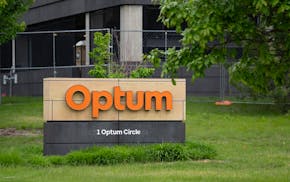Office vacancies in the core of downtown Minneapolis reached a new high this fall despite a flurry of lease signings and a steady flow of workers filing back to their cubicles.
By the end of September, the average office vacancy rate in the central business district (CBD) of downtown rose slightly to 23.4%, according to a quarterly report from Colliers. The situation was even worse in downtown St. Paul, which saw a 29% vacancy rate, while the combined suburbs rose to 11.5%.
Those increases come even as companies are looking for new space and asking employees to return to the office, though not at the pace — or scale — necessary to offset the amount of vacated space. The situation has been vexing for commercial brokers, who have watched office tenants shrink their spaces yet ask for more sophisticated amenities, and for building owners who are struggling to figure out what's next for properties that are fast declining in value.
"[Leasing] activity is stronger than it was 12 months ago, and certainly 24 months ago," said Kevin O'Neill, an executive vice president for Colliers. "But I think there's too much office space in downtown Minneapolis for the demand right now. And we'll continue to need alternative uses for some of these buildings."
O'Neill and other commercial real estate brokers said as companies downsize, they're looking for higher-quality space in the best locations with the kinds of amenities that will lure back workers.
That "flight to quality" is why vacancies in those luxury "Class A" buildings have remained steady while older, less desirable buildings continue to empty, according to the report. Multi-tenant buildings saw a sharp rise in vacancy from 18.4% last quarter to 19.6% this quarter; that's up 12.5% year-over-year.
The Colliers report said large corporate downsizes, especially by banks and state agencies, drove the rise in vacancies last quarter. Most of the buildings that sold were distressed properties, facing high vacancy and debt challenges.
The downtown core is also struggling with the loss of several large office tenants who have signed leases in adjacent areas, including the North Loop neighborhood and the West End in St. Louis Park, which have both seen robust leasing activity and rents that outpace the rest of the region. This summer, office tenants, including some from the CBD, began moving into the massive mixed-use North Loop Green, which is in demand.
Suburban vacancy rates are highest along the I-494 Corridor, but that's down slightly from the previous quarter. The downtown buildings experiencing the highest vacancies are typically older buildings or those on the fringes of the market. That trend is likely to continue as tenants relocate and downsize.
Balancing act
One such relocation will bring about 250 new employees to downtown Minneapolis next summer: Wold Architects & Engineers recently announced it would move its headquarters from downtown St. Paul to downtown Minneapolis' 50 South Sixth building.
But those kinds of shifts aren't offsetting a few large vacancies weighing down the CBD. About half the space up for sublease in the metro is in downtown Minneapolis, which has yet to fill the nearly 1 million-square-foot hole Target left in the City Center. The Ameriprise Financial Center is also emptying as its namesake tenant consolidates workers in another downtown property.
Signs of the stress on office building owners are starting to show. The Dayton's Project, the much-heralded $350 million redevelopment of the former department store on Nicollet Mall, went into receivership last month. The lender for the project launched foreclosure proceedings after paying nearly $4 million "to avoid the termination of various utilities and essential services," according to court documents.
And last fall, the owner of the Ameriprise Financial Center essentially handed the keys back to its lender, according to documents filed with Hennepin County. Ryan Watts, executive vice president in CBRE's Minneapolis Institutional Properties Group, said that 31-story tower is now available for lease or for sale.
"We don't know how that's going to shake out in the sale and lease market," he said. "We're trying to attract as many interested folks as we can."
Watts said as restaurants, sports venues and other attractions open — and the city addresses perceived public safety issues — there's been an uptick in the number of investors looking for Minneapolis opportunities.
"You can clearly see the fundamentals improving," Watts said. "You can feel that vibrancy, and that's ultimately the foundation that's needed to get investors to re-invest in the city."
High vacancies are also putting downward pressure on building values, forcing a handful of building owners to sell at prices significantly lower than just a few years earlier.
Last month, a pair of office towers known as the Forum sold for $6.5 million, a more than 90% discount compared with the nearly $74 million sale price in 2019. For tax purposes, Hennepin County said the building is worth about $30 million.
The nearly 20-story towers built in the mid-1980s have a combined 634,000 square feet across from the Foshay Tower and are home to Ruth's Chris Steak House, which recently renewed its lease.
A trio of LLCs tied to East Coast-based Namdar Realty Group bought them. Namdar invests in shopping malls but has recently been buying distressed office buildings at steep discounts across the country.
CBRE, which marketed the property, declined to comment on the sale.
Low price, high optimism
Adam Duininck, president and CEO of the Minneapolis Downtown Council, said while the low sales prices might sound alarming, there are bright spots. Homeowners in the city are facing a few tough years of property tax increases as commercial values drop, he acknowledged. But the lower prices have also enabled new players to buy downtown properties, paving the way for fresh ideas to transform the urban core.
"Hopefully, they come into the market with a certain kind of energy and optimism that helps drive the market back up," he said, adding public safety improvements have also fueled recent momentum.
Take the Kickernick Building, which recently opened an art gallery. Earlier this year, Twin Cities-based United Properties sold the historic former warehouse on the edge of the CBD for $3.79 million. In 2017, United paid $19.5 million for the building.
Just a couple blocks away, Tom McCarver and Steve Boynton bought a mixed-use, nearly 31,000-square-foot building at the corner of Seventh Street and Hennepin Avenue that most recently housed Seven Steakhouse & Sushi. Last month, they paid about $4.3 million, slightly more than half of what it sold for in November 2017.
After the restaurant closed during the pandemic, the building went into receivership and up for auction. McCarver and Boynton, executives at a company that owns billboards across the metro, were among nearly a dozen bidders. They won the auction in March, but because of "legal hurdles," the sale didn't close until last month.
"I have seen [the building] go through lots of iterations," McCarver said.
What's next for the empty building, McCarver said this week, isn't clear. He and Boynton bought it because they're optimistic about the future — however many years away — for the area, which is in close proximity to three major sports venues, First Avenue and the Theater District.
"We did it because we just really believe in the downtown area, which is certainly going through a stretch of tough times, but we can't imagine that it won't be anything but great again," McCarver said. "A new chapter is being written, and we get that, and we want to be a part of that area."

Delta hiked fares for solo travelers, until Twin Cities travel experts caught the change

In first speech back, UnitedHealth's new CEO pledges to review hot-button issues

A child had measles at Mall of America, concerning state health officials who don't know source

Ramstad: Gov. Walz, things are not getting done in Minnesota

